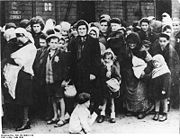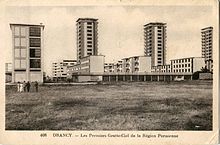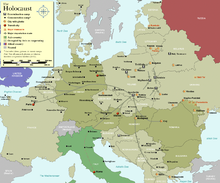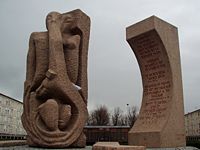- Drancy internment camp
-
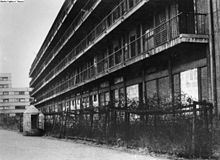 The internment camp at Drancy, outside Paris, where Jews were confined until they were deported to the death camps.
The internment camp at Drancy, outside Paris, where Jews were confined until they were deported to the death camps.
The Drancy internment camp of Paris, France, was used to hold Jews who were later deported to the extermination camps. 65,000 Jews were deported from Drancy, of whom 63,000 were murdered[1] including 6,000 children. Only 2,000 remained alive when Allied forces liberated the camp on 17 August 1944.
Drancy was under the control of the French police until 1943 when administration was taken over by SS and officer Alois Brunner. In 2001, Brunner's case was brought before a French court by Nazi hunter Serge Klarsfeld, which sentenced Brunner in absentia to a life sentence for crimes against humanity.[2]
Contents
Creation of Drancy internment camp
After the 1940 defeat by Germany and the 10 July 1940 vote of full powers to Marshal Philippe Pétain, the Republic was abolished and Vichy France was proclaimed. The Vichy government cooperated with Nazi Germany, hunting down foreign and French Jews and turning them over to the Gestapo for transport to the Third Reich's extermination camps.
The Drancy internment camp became identified by the northeastern suburb of Paris in which it was located. It was originally conceived by the noted architects Marcel Lods and Eugène Beaudouinas as a striking, modernist urban community. The design was especially noteworthy for its integration of high-rise residential apartment towers, among the first of their kind in France. Poetically named La Cité de la Muette ("The Silent City") at its creation for its perceived peaceful ideals, the name became twisted with bitter ironic meaning. The entire complex was confiscated by Nazi authorities not long after the German occupation of France in 1940. It was used first as police barracks, then converted into the primary detention center in the Paris region for holding Jews and other people labeled as "undesirable" before deportation.
On 20 August 1941, French police conducted raids throughout the 11th District of Paris and arrested more than 4,000 Jews, mainly foreign or stateless Jews. French authorities interned these Jews in Drancy, marking its official opening. French police enclosed the barracks and courtyard with barbed-wire fencing and provided guards for the camp. Drancy fell under the command of the Gestapo Office of Jewish Affairs in France and German SS Captain Theodor Dannecker. Five subcamps of Drancy were located throughout Paris (three of which were the Austerlitz, Lévitan and Bassano camps).[3] Following the Vel' d'Hiv Roundup on July 16 and 17, 1942, more than 4,900 of the 13,152 victims of the mass arrest were sent directly to the camp at Drancy before their deportation to Auschwitz.
Drancy was under the control of the French police until 3 July 1943 when Germany took direct control of the Drancy camp. SS officer Alois Brunner became camp commandant as part of the major stepping up at all facilities needed for mass extermination. The French police carried out additional roundups of Jews throughout the war. Some Drancy inmates died as hostage pawns. In December 1941, 40 prisoners from Drancy were executed in retaliation for a French attack on German police officers[3].
The Drancy camp was designed to hold 700 people, but at its peak held more than 7,000. There is documented evidence and testimony recounting the brutality of the French guards in Drancy and the harsh conditions imposed on the inmates. For example, upon their arrival, small children were immediately separated from their parents for deportation to the death camps.[3]
On 6 April 1944, SS First Lieutenant Klaus Barbie raided a children's home in Izieu, France, where Jewish children had been hidden. Barbie arrested everyone present, all 44 children and 7 adult staff members. The next day, the Gestapo transported the arrestees to Drancy. From there, all the children and staff were deported to Auschwitz. None of them survived.[3]
Many French Jewish intellectuals and artists were held in Drancy, including Max Jacob (who died there)[4], Tristan Bernard, and the choreographer René Blum. Of the 75,000 Jews whom French and German authorities deported from France, over 65,000 were sent directly from Drancy to Auschwitz. Only 2,000 survived their captivity.[3]
The camp today
In 1976, the Memorial to the Deportation at Drancy was created by sculptor Shlomo Selinger to commemorate the French Jews imprisoned in the camp.
Until recently, the official point of view of the French government was that the Vichy regime was an illegal government distinct from the French Republic. While the criminal behaviour of Vichy France and the collaboration of French officials were acknowledged, and some former Vichy officials prosecuted, this point of view denied any responsibility of the French Republic. This perspective, held by Charles de Gaulle among others, underlined in particular the circumstances of the July 1940 vote of the full powers to Marshal Pétain, who installed the "French State" and repudiated the Republic. With only the Vichy 80 refusing this vote, historians have argued it was anti-Constitutional, most notably because of pressure on parliamentarians from Pierre Laval.
However, on 16 July 1995, president Jacques Chirac, in a speech, recognized the responsibility of the French State, and in particular of the French police which organized the Vel' d'Hiv Roundup (Rafle du Vel' d'Hiv) of July 1942 , for seconding the "criminal folly of the occupying country".[5]
On 20 January 2005, arsonists set fire to some railroad freight cars in the former camp; a tract signed "Bin Laden" with an inverted swastika was found on the place.
On 11 April 2009, a swastika was painted on the train car used for the deportation of Jews, a permanent exhibit. This action was condemned by the French Minister for the Interior, Michèle Alliot-Marie.[6]
See also
- Vichy France
- Alois Brunner
- Concentration camps in France
- Pitchipoi
- David Feuerwerker Commemoration at Drancy
- German occupation of France during World War II
Documentary Films
- Drancy: A Concentration Camp in Paris 1941-1944, Worldview Pictures, 1994.
- Drancy Avenir, 1997.
Literature
Nicolas Grenier, Cité de la Muette (poem), in honor of Max Jacob, who died in the Drancy camp, 2011.
References
- ^ "This Month in Holocaust History - December - Drancy". Yad Vashem. http://www1.yadvashem.org/this_month/december/drancy.html. Retrieved 7 July 2009.[dead link]. The 61,000 deported to Auschwitz and 3,000 to Sobibor were murdered
- ^ Biography at the Jewish Virtual Library
- ^ a b c d e United States Holocaust Memorial Museum. "Drancy" article for the Holocaust Encyclopedia. http://www.ushmm.org/wlc/en/index.php?ModuleId=10005215&MediaId=1580 (accessed July 5, 2009).
- ^ The french poet Nicolas Grenier wrote a tribute to Max Jacob died in the camp
- ^ En 1995, la reconnaissance des « fautes commises par l'Etat », Le Monde, 25 January 2005 (French)
- ^ Swastikas painted on French memorial. Jerusalem Post, 11 April 2009 Des croix gammées tracées au Mémorial de la déportation à Drancy. Le Monde, 11 avril 2009.
Coordinates: 48°55′12″N 2°27′18″E / 48.92°N 2.455°E
The Holocaust in France - Main article: The Holocaust
- Related articles by country:
- Belarus
- Estonia
- Latvia
- Lithuania
- Norway
- Poland
- Russia
- Ukraine
Crimes - Vel' d'Hiv Roundup
- Drancy
Victims - Andrée Borrel
- Per Jacobsen
- Vera Leigh
- Sonya Olschanezky
- Marcel Pourchier
- Diana Rowden
Perpetrators - Otto Abetz
- Ernst Achenbach
- Horst Ahnert
- Klaus Barbie
- Werner Best
- Kurt Blanke
- Karl Bömelburg
- Alois Brunner
- Theodor Dannecker
- Hans-Dietrich Ernst
- Herbert Hagen
- Ernst Heinrichsohn
- Helmut Knochen
- Kurt Lischka
- Carl Oberg
- Heinz Röthke
- Carltheo Zeitschel
Nazi occupation and organizations Collaborators Camps - Drancy
- Gurs
- Camp de Rivesaltes
- Fort de Romainville
- Vernet
- Natzweiler-Struthof
- (subcamps)
Survivors - Anthony Faramus
- Alf Grindrud
- Albert Guérisse
- Asbjørn Halvorsen
- Arne Brun Lie
- Kristian Ottosen
- Boris Pahor
- Haakon Sørbye
- Brian Stonehouse
- Prince Xavier of Bourbon-Parma
Documentation Righteous among the Nations - Albert Bedane
- Marc Boegner
- Le Chambon-sur-Lignon
- Château de Chabannes
- Jacques Ellul
- Pierre-Marie Gerlier
- Justin Godart
- Père Jacques
- Père Marie-Benoît
- René de Naurois
- Paul Ramadier
- Germaine Ribière
- Jules-Géraud Saliège
- Pierre-Marie Théas
- André and Magda Trocmé
Memorials - Sons and Daughters of Jewish Deportees from France
- Rivesaltes Memorial
Categories:- Deportation
- Nazi concentration camps in France
- Vichy France
- Seine-Saint-Denis
- The Holocaust in France
- Internment camps in France
Wikimedia Foundation. 2010.

